Features of growing an orchid and caring for it
Phalaenopsis is a capricious flower. But, if you properly organize the care of the orchid at home, it will delight with abundant flowering at least 2 times a year. Care, in addition to watering and feeding, includes organizing a certain level of air humidity and temperature, replanting a flowerpot.
- Conditions of detention
- Lighting
- Temperature
- Humidity
- Organization of watering
- Phalaenopsis substrate
- Pot selection
- Growing on blocks
- Phalaenopsis feeding and transplanting
- Transfer
- Phalaenopsis diseases
- Fungal diseases
- Viral diseases
- Other problems
- Reproduction of phalaenopsis
- By dividing the bush
- Shoots
- Cuttings
- Phalaenopsis selection
- Conclusion
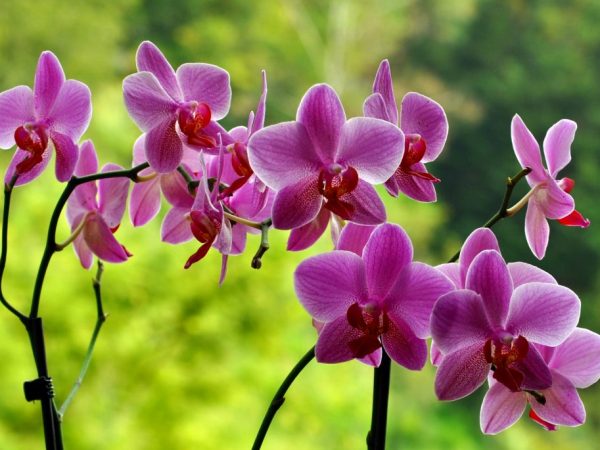
Features of growing an orchid and caring for it
Conditions of detention
It is not difficult to take care of an orchid at home, there is to organize the necessary conditions for it.
Lighting
The orchid loves moderate light. If there is not enough light, it will not bloom. If the light is too intense, the phalaenopsis burns out. A sunny windowsill is suitable for a plant. In winter, phalaenopsis needs 2-3 hours of finishing.
It is determined whether the orchid has enough light by the color of the leaf plates. If they are deep green, then there is not enough light. If the leaf plates begin to turn yellow, then there is too much light.
A pot with a flowerpot should be placed on the eastern window sills.
Temperature
So that orchids in transparent pots do not disappear, they must be provided with a certain temperature regime. It varies somewhat depending on the type of phalaenopsis. But most plants do well at room temperature. Daytime 18-27 ° C, at night 13-24 ° C.
The temperature drop is organized by transferring the flowerpots at night to an insulated balcony or loggia.
If the air temperature is above normal, the flower is watered more often. If it is below the norm, the number of waterings is reduced.
Humidity
Proper care of orchids at home requires adherence to air humidity standards. The optimum humidity is 60 to 80%.
To create acceptable conditions for the flower, a tray with a grate filled with water is installed under the pot. The roots of the plant and the bottom of the tray should not come into contact with water.
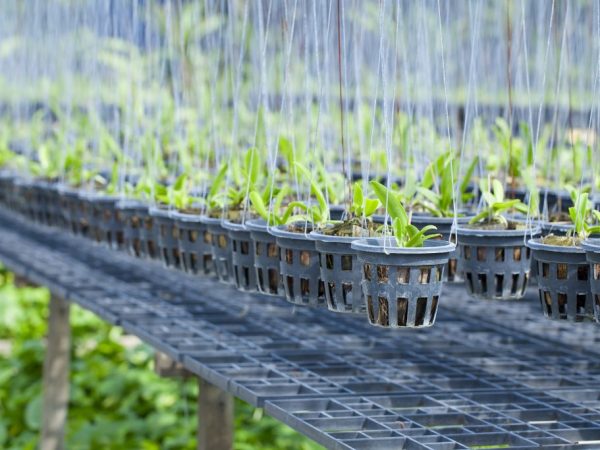
Optimum humidity for orchids is from 60 to 80%
In the summer, the leaf plates should be sprayed with water at room temperature. This procedure is performed during the day. The leaves of the plant should be dry at night.
If the air humidity is within the normal range, air circulation should be organized in the room. This moment is especially important for those species that love the cold. If the natural ventilation of the air in the room is insufficient, use electric fans. There should be no drafts while the fan is running.
Organization of watering
Proper home care for your orchid includes watering. Some phalaenopsis need to keep the substrate constantly moist. Other plants are watered when the substrate is completely dry. When buying a flower, you need to consult a store consultant on this issue and study the information about the plant.
With excessive watering, the roots of the plant turn black and rot, the leaves darken. With a lack of moisture, the leaf plates turn yellow and begin to wrinkle, the pseudobulbs fade. The intensity of watering also depends on the flowering phase. At the moment of ejection of the peduncle and flowering, the amount of watering is increased. Needs watering for active growth. After flowering, the amount of watering is reduced.
Instead of watering them normally, they are watered from the shower for a few minutes. Then the excess water is allowed to drain and the plant is returned to the windowsill.
Alternatively, the flower pots are placed in a container filled with water for 15 minutes. Through the drainage holes, water will enter the pot and moisturize the substrate. After the time has elapsed, the pots are removed and the excess water is allowed to drain. Orchids are watered only with warm water.
Phalaenopsis substrate
When growing orchids at home, a special substrate is used. He must:
- good air flow;
- keep a minimum amount of water;
- do not let the flowerpot fall out of the pot.
Ordinary soil does not allow air to pass through well and retains moisture, so it is not added to the substrate for phalaenopsis. It consists of crushed bark of various trees, moss, coal, coarse sand, perlite, cork and granular clay. The substrate is easy to make on your own, but agronomists recommend purchasing ready-made mixtures in specialized stores.
In addition to the above components, dry leaves can be added to the substrate. But with excessive watering, they will rot, as a result of which the roots of the flowerpot will also begin to rot. Leaves should not be added to the substrate for orchids, the soil of which must be constantly moist. When formulating a substrate for phalaenopsis varieties that require little moisture, dry leaves are an acceptable supplement. Moss also retains moisture.
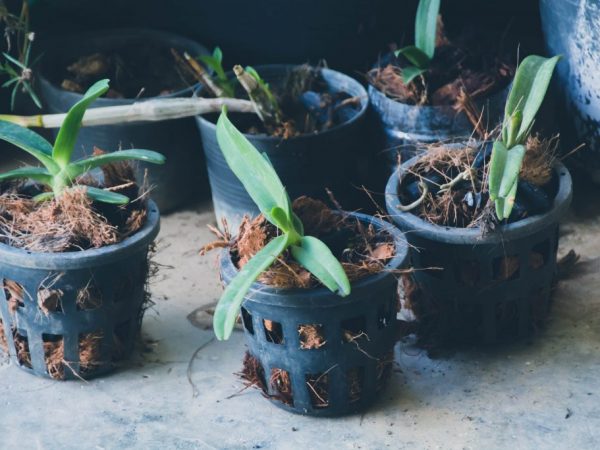
For the substrate, it is better to purchase ready-made mixtures
Pot selection
To care for an orchid in a pot, it must be transparent. In opaque containers, it is difficult to monitor the condition of the roots. Suitable not only plastic containers, which are currently the most popular, but also pots made of wire, unnecessary baskets, etc. The main thing is that the container holds the substrate with the flowerpot. The phalaenopsis pot should have a large number of holes through which excess water will drain. Glass pots are an alternative to plastic ones. They are more stable and better support the flowerpot in an upright position. But their pricing policy is higher, and punching holes in glass is more difficult than in plastic.
From an opaque container, ceramic pots should be used, having previously made round holes not only at the bottom of the pot, but also in the side walls. This is done so that there is a normal air exchange around the roots. The advantage of a ceramic pot is that it is not heated by the sun's rays, protecting the roots of the plant from burns.
Growing on blocks
Still grow phalaenopsis on blocks, which are used as the bark of oak or pine. The rules for growing on blocks are the same as for growing in a pot. The peculiarity here is that the roots dry out quickly after watering. Maintenance is somewhat complicated by the need for more frequent watering. But the orchid looks much more attractive on blocks than in a pot.
Phalaenopsis feeding and transplanting
For normal development, it is not enough just to properly care for the orchid at home. The plant needs additional nutrition. You need to use special mixtures that are sold in specialized stores. The flowerpot is fed during active growth, during the swelling of the pseudobulb and after flowering. There are different dressings for each period. All information on when and how to use each product is on the label. In autumn and winter, feeding is carried out no more than 1 time per month.In the spring, the plant is fed about 3 times every 2 months.
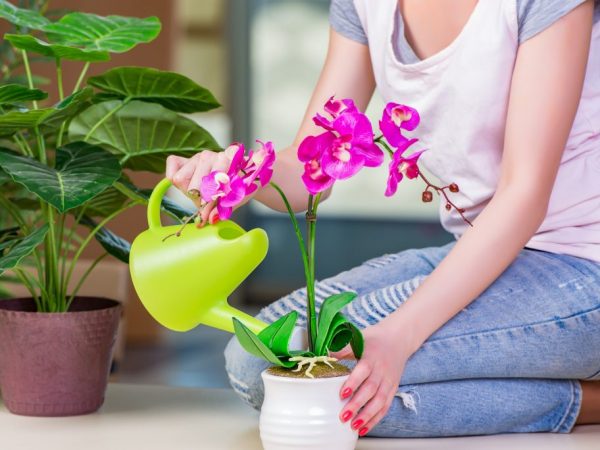
The orchid needs additional nutrition
Transfer
The transplanting technology is simple, but you need to be careful when replanting a plant for which this procedure is stressful. Often and systematically, this procedure is not worth it. The recommendations for caring for a room orchid indicate that it should be transplanted if it is necessary to replace the substrate and if the flowerpot has outgrown the pot. Replace the substrate if the flowerpot starts to hurt. The plant is transplanted 5-7 days after the end of flowering. It is carefully taken out of the old pot. Soak in water and remove the old substrate. If the pot is sick, then the substrate is removed completely. Remove all dead and damaged roots. Places of cuts are sprinkled with wood ash, and the cut parts are thrown away. The plant is placed in a new pot, having previously covered its bottom with a thin layer of new substrate, and covered with fresh substrate. The transplanted flowerpot is placed in the shade for 2-3 days. The first watering of the transplanted orchid is carried out immediately in the transplant field. The next watering of the transplanted orchid occurs in 10-14 days.
In order not to damage the root system while removing the flowerpot from the old pot, it is cut.
Phalaenopsis diseases
Taking care of a sick orchid is difficult. Often, the affected plants die. Most often, phalaenopsis are exposed to fungal and viral diseases.
Fungal diseases
Fungal diseases are characterized by the appearance of small tubercles on the leaf plates and peduncles. Inside these tubercles are fungal spores. It is impossible to open the tubercles. This will speed up the spread of fungal spores.
If the damage is at the edge of the sheet plates, then the damaged parts are removed. If the tubercles are located on the entire surface of the leaf, then the plant is treated with fungicides. In parallel with the treatment of the flowerpot with fungicides, they completely replace the soil.
Viral diseases
Viral diseases are not cured. Sick plants are destroyed. Determine the presence of the virus by spots of yellow or brown color on the leaves. Sometimes a gray bloom appears on the inside of the leaf.
If a virus is suspected, the plant should be treated with an antibiotic and fungicide. If the treatment has not yielded results, the flowerpot is removed away from healthy plants, and its condition is monitored. If the presence of the virus is confirmed, the flowerpot is thrown away.
Other problems
Often the flower withers and withers due to improper care.
- It is impossible to grow a plant with large leaves at home in low light. The lack of light also has a negative effect on flowering. The flowers are pale, and the flowerpot produces one peduncle. In rare cases, the plant produces two or more arrows, on which no more than 4-5 flowers are formed.
- Burns are large yellow spots. The plant receives a chemical type of burn when feeding with highly concentrated fertilizers or processing with improperly diluted insecticides.
- With excessive watering, the roots of the flower rot, and the leaves become wrinkled and acquire a yellow-brown color, become watery. Sometimes mold appears. The leaves become wrinkled when there is a lack of moisture.
- Under the influence of low temperatures, the leaves first wither, then acquire a yellow-brown color and become wrinkled.
When a flowerpot is grown in a ceramic pot, its health is judged by its aerial roots. If the aerial roots dry out or rot, then the plant is unhealthy. Damaged aerial roots must be removed.
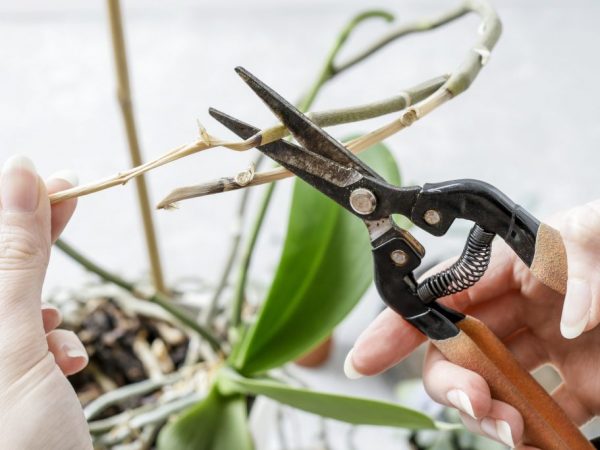
An orchid may die due to improper care.
Reproduction of phalaenopsis
Reproduction of the flowerpot occurs by dividing the rhizome, shoots, cuttings or seeds. Growing a plant from seeds is possible only in the laboratory. Use the method when growing orchids on an industrial scale. At home, reproduction should be done in any other way.
By dividing the bush
The easiest way for novice gardeners is to breed by dividing the rhizome. Autumn is the best time for the procedure. Division is also carried out in the summer, after the plant has bloomed. It is undesirable to touch the plant in the spring. When propagating by dividing the rhizome, sharp garden shears or a knife are needed. There must be at least 3 false bulbs on it to get a viable plant. The resulting flowerpots are planted in separate pots. Caring for them is carried out according to the same rules as for adult plants.
Plant transplant is combined with reproduction.
Shoots
Some varieties have lateral shoots (babies). Children are formed from the kidney. After the babies have grown stronger, they are separated from the mother tree. Planting children is done in the same way as transplanting a flowerpot. To make the children grow faster, the plant is fed with nitrogen-containing fertilizers.
Tubers bought abroad do not always take root. In accordance with the advice of agronomists, plants should be planted that have acclimatized to a specific region. They will grow faster and easier to care for.
Cuttings
Planting with cuttings is the most difficult. The shoot is cut at an angle with a sterile knife. The cut site is disinfected, after which the cutting is planted in a separate pot. Small shoots with poorly developed nodes are not suitable for propagation by cuttings. Large shoots are cut ½ the length.
Phalaenopsis selection
The choice of a potted orchid should be governed by the conditions that the owner can provide to the flowerpot, not by its appearance or attractive name.
The unpretentious varieties are Burrageara, Berry, Oncidium, Bernard, Wanda, Kolibri, Dendrobium Nobile. Beautiful, but capricious are the Bamboo Orchid and Vietnamese or Vietnamese. The street bush variety, which is grown in the garden, attracts attention. Its maintenance requires the presence of greenhouses.
There are blue phalaenopsis on sale. They are obtained artificially, and in the second generation the plant produces white flowers. If the painting technology is not followed or cheap materials are used, irreparable damage to the flowerpot is caused, and it is difficult to reanimate it.
Conclusion
When growing phalaenopsis, a number of rules should be followed. There are also folk secrets of plant care. Recently, a method for growing phalaenopsis in a bottle has appeared, which is hermetically closed after the sprout is placed in it and placed on the window. Water is poured into the bottom of the bottle.
The peduncle is removed after flowering, even if it has buds. Someone leaves a part of the peduncle, on which 3-4 buds are located, from which children or a new peduncle may subsequently appear. If neither the peduncle nor the shoot appeared, then the kidney did not wake up.


